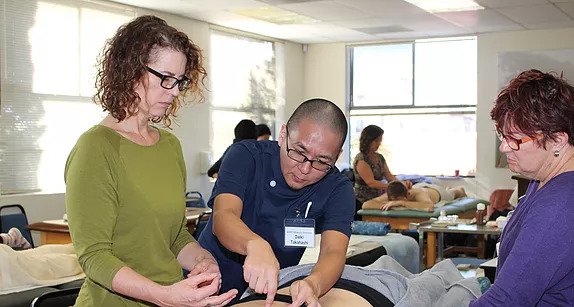Hands-on Training in Shakuju Therapy
- AIMC

- Nov 26, 2017
- 3 min read
The weekend of October 7th and 8th, Daiki Takahashi, Saori Tasaka, and Tisha Mallon L.Ac held a Shakuju therapy (SJT) Training Seminar at AIMC-Berkeley. Over 20 participants attended from all over the country to learn the theory and hand-on techniques of SJT, as well as abdominal diagnosis, contact needling, moxibustion, bloodletting, and how to perform root treatment.
SJT was developed by master Shoji Kobayashi over 40 years ago in Japan. He is known for his deep inquiry into the I-Ching and the Classic texts, and for applying effective comprehensive treatments to the most difficult cases. As a teacher he tried to find a system that students could acquire within a 3-year course which would treat patients with positive effect. The system of SJT is organized in a simple manner so that beginners just out of school can apply it readily in treating patients.
The main point of SJT is that a disease is formed by the deficiency of the body's vital force called Jing Qi (精氣). If there are symptoms in the body, there is a fundamental deficiency of Jing Qi or coldness (Hie) underneath. The purpose of treatment is to empower the Jing Qi to warm up the body through SJ needle or SJ teishin, moxibustion, and bloodletting as needed. SJT treats all conditions, especially trauma, children, and elderly patients.

Instructors, Daiki Sensei and Saori Sensei are teachers at GOTO college in Tokyo, which is the sister school of AIMC. Their passion for acupuncture is tangible. Besides busy schedule as teachers, they have come to the U.S. every year since 2005. They have been teaching SJT in Boston, Austin, Hawaii, and the Bay Area. With the support of Tisha Mallon L.Ac, the seminar was made possible for the third time at AIMC.
According to Daiki Sensei, he treats many patients at three different clinics and sometimes he encounters patients with a disease that he has never heard of before. Under this challenging situation, he is able to start treatment and diagnose based on checking the pulse, K-points (Kobayashi points), and abdominal palpation.

Daiki Sensei said that choosing proper tools is very important. For example, in TCM theory, basically, moxibustion is used for warming up a body. On the other hand, in SJT theory, moxibustion is not only meant to warm up but also give vital power to the body like a medicine. Tonetsu-kyu (rice grain moxa) has strong stimulation, while Chinetsu-kyu (cone moxa) has mild stimulation. They should be used differently depending on the degree of vital power. As the skill improves, the practitioner is able to make a faster diagnosis, choose the tool and treat the patient. "The sooner the treatment, the greater the benefits", say Daiki Sensei.
James Constantine, a 7th term AIMC student, said "I really enjoyed this seminar. It is my second. The instruction was clear, concise, and the translation was excellent. But I think that what stood out the most is the passion of the participants. They have experienced the power of this therapy and attend every seminar they can get their hands on. I met people at the seminar who haven't missed one in 7 years. It's really amazing."
Hopefully, they will be back again next year. SJT continues to develop through master Kobayashi's clinical experience. As one of their students, I think the belief in the treatment and the effort to improve one’s own skill are the best ways to make this profound medicine effective and powerful.





Comments